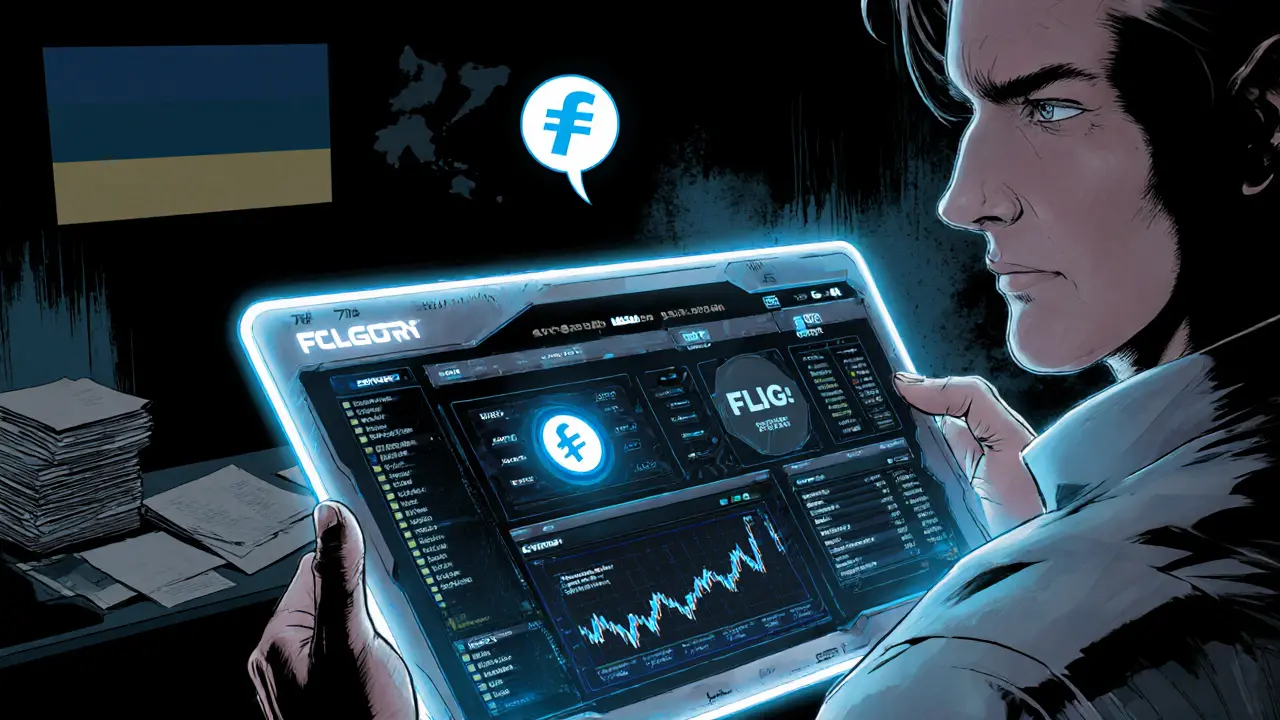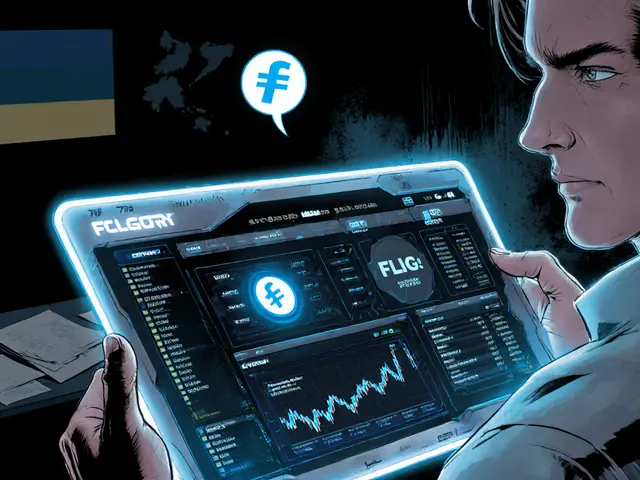- Home
- Cryptocurrency
- Folgory Crypto Exchange Review: Is It a Scam or a Failed Platform?

Folgory Crypto Exchange Review: Is It a Scam or a Failed Platform?
Folgory Exchange Risk Checker
Folgory (Failed Model)
Launched in 2019, claimed licenses in Estonia and Seychelles, but went offline in April 2025.
Offline Since Apr 2025Safe Alternatives
Exchanges like Binance, Coinbase, and Kraken offer verified licensing, high uptime, and strong security.
Active & RegulatedRisk Assessment
When you hear the name Folgory is a centralized cryptocurrency exchange that claimed to operate from Estonia and the Seychelles, you probably picture a sleek trading app, a fiat gateway, and a native token promising launchpad perks. But the reality turned out to be far messier. In October2025 the platform’s website has been down for six months, users are reporting lost funds, and the community is labeling it as one of the worst scams in crypto. This review pulls together the timeline, feature promises, user complaints, regulatory red flags, and a quick side‑by‑side look at reputable alternatives so you can decide whether to stay away or try to recover what you might have left.
Quick Summary
- Folgory launched in 2019, claimed licences in Estonia and the Seychelles.
- Offers (on paper) crypto‑to‑crypto, crypto‑to‑fiat, margin, launchpad, and an FLG token.
- Website went offline on 18April2025 and has stayed down.
- Multiple community threads describe it as a scam, with users unable to access funds.
- Compare the promised features against established exchanges like Binance, Coinbase, and Kraken before any further exposure.
What Folgory Claims to Be
According to its marketing material, Folgory promised a full‑service crypto exchange with fiat gateway support for USD, EUR, and GBP, credit‑card purchases, margin trading up to 5×, a decentralized exchange overlay, and an over‑the‑counter (OTC) desk. The platform also introduced a native token, FLG designed to power token launches on the Folgory blockchain, and a launchpad that allegedly gave early investors access to new projects.
On the surface, those features line up with the services offered by top‑tier exchanges, but the devil is in the details: licensing, security audits, and actual user access. Folgory’s white‑paper repeatedly emphasized a “regulated” status in Estonia while the footer of its site listed a Seychelles address, suggesting a possible regulatory arbitrage strategy.
Timeline and Current Status
- 2019 - Folgory goes live, touts "Estonian financial exchange" licence.
- 2020‑2023 - Adds fiat on‑ramps, mobile apps, and the FLG token.
- 2024 - Receives mixed reviews; some users praise low fees, others raise withdrawal delays.
- 18April2025 - The domain
folgory.combecomes inaccessible. All API endpoints return “site not found”. - May‑Oct2025 - Community posts on Bitcoin Forum, Reddit, and various crypto Discords label the exchange a scam; users report being locked out of wallets holding Bitcoin, Ethereum, and dozens of altcoins.
As of today the site remains offline, with no official statement, no support email that works, and no indication of a resurrection plan.
Feature Promises vs. Reality
Below is a quick reality check of the headline features Folgory advertised.
- Fiat gateways (USD/EUR/GBP) - The exchange claimed bank‑level integration, but users who attempted to deposit fiat reported “transaction pending” for weeks before the site vanished.
- Margin & leverage trading - Promotional screenshots showed a 5× leverage UI, yet no third‑party audit ever verified the margin engine. After the blackout, leveraged positions were left open with no liquidation engine.
- Decentralized exchange overlay - Supposedly allowed peer‑to‑peer swaps without fees. In practice, the DEX module never received a smart‑contract audit, and users could not see their order books before the shutdown.
- Launchpad & FLG token - The FLG token never listed on any reputable market, and the launchpad projects were either abandoned or migrated to other platforms.
- Mobile apps - iOS and Android builds existed, but both stopped receiving updates after March2025. Login screens now display a generic “service unavailable” error.
In short, the advertised toolbox looks impressive on paper but fell apart when users tried to use it.

User Experiences and Red Flags
If you browse the Bitcoin Forum thread titled "Worst scam exchange I've seen", you’ll see dozens of screenshots showing abandoned withdrawal tickets, empty inboxes, and a final message that reads "We are currently undergoing maintenance - please try again later" - a message that has persisted for months.
Red‑flag checklist that repeatedly appears in community posts:
- Website goes offline without prior notice.
- Inconsistent corporate location (Estonia vs. Seychelles).
- No verifiable licence number on a regulator’s public register.
- Customer support replies vanish after the site shuts down.
- Withdrawal fees that increase dramatically just before the shutdown.
These signals line up with classic exit‑scam patterns seen in other failed exchanges.
Regulatory & Location Concerns
Legitimate exchanges usually register with a single, well‑known regulator - the FCA in the UK, the SEC in the US, or the Estonian Financial Intelligence Unit (FIU) for EU‑based services. Folgory’s claim of an "Estonian financial exchange licence" never appeared on the FIU’s official list. Meanwhile, the Seychelles address was listed only in the privacy policy and seemed to be a mailbox service rather than a corporate office.
This dual‑location claim raises two worrying possibilities:
- Folgory was trying to benefit from the relatively lax regulatory environment of the Seychelles while sprinkling an EU‑centric licence claim to appear trustworthy.
- The platform never secured any proper licence at all, leaving users without legal recourse when the service vanished.
For anyone weighing a new exchange, checking a regulator’s public register should be a non‑negotiable step.
How Folgory Stacks Up Against the Big Players
| Feature | Folgory | Binance | Coinbase | Kraken |
|---|---|---|---|---|
| Fiat on‑ramps (USD/EUR/GBP) | Claimed, unverified | Supported, audited | Supported, regulated | Supported, EU‑licensed |
| Margin/Leverage | 5×, no public audit | Up to 125×, transparent risk engine | Limited, regulated | Up to 5×, audited |
| Native token | FLG (inactive) | BNB (active, listed) | USDC (stablecoin, not native) | None |
| Regulatory status | Unclear, conflicting claims | Registered in Malta, Cayman Islands | US‑based, regulated in 30+ jurisdictions | US‑based, EU‑licensed |
| Website uptime (2024‑2025) | Offline since Apr2025 | 99.9%+ uptime | 99.9%+ uptime | 99.9%+ uptime |
The table makes it clear: Folgory’s promises look similar, but the execution and trust signals are nowhere near the standards set by Binance, Coinbase, or Kraken.
Safety Lessons and Safer Alternatives
What can you learn from Folgory’s collapse?
- Never keep large balances on a single exchange. Use hardware wallets or reputable custodial services for long‑term storage.
- Validate licences. A quick search on the regulator’s website will reveal whether an exchange is genuinely listed.
- Check community sentiment. A handful of negative reviews are normal, but a flood of “scam” tags across multiple forums is a red flag.
- Test withdrawals early. Deposit a small amount, withdraw it, and confirm the process works before committing more capital.
- Prefer exchanges with transparent security audits. Companies that publish third‑party audit reports give you a concrete way to assess risk.
If you’re looking for a safe place to trade, the market leaders listed in the comparison table have proven track records, transparent fee structures, and regulatory oversight. They also keep their websites up 24/7, which is a basic expectation in 2025.
Frequently Asked Questions
Is Folgory still operational?
No. The website folgory.com has been offline since 18April2025, and there have been no official communications from the team about a relaunch.
Can users recover funds locked on Folgory?
Recovery is unlikely at this point. With the platform’s servers down and no legal entity clearly registered, users have little recourse beyond filing complaints with consumer protection agencies in the jurisdictions they suspect the company operated from.
What is the FLG token?
FLG was Folgory’s native utility token meant for launching new projects on its blockchain. Since the exchange is defunct, FLG has essentially lost any utility and trades at negligible value, if it trades at all.
How can I verify if an exchange is licensed?
Visit the regulator’s official website (e.g., Estonia’s FIU, the UK's FCA, or the US SEC) and search for the exchange’s name or licence number. Legitimate firms publish this information publicly.
Are there any reputable alternatives to Folgory?
Yes. Exchanges like Binance, Coinbase, and Kraken offer robust security, clear regulatory compliance, and active customer support.
Cormac Riverton
I'm a blockchain analyst and private investor specializing in cryptocurrencies and equity markets. I research tokenomics, on-chain data, and market microstructure, and advise startups on exchange listings. I also write practical explainers and strategy notes for retail traders and fund teams. My work blends quantitative analysis with clear storytelling to make complex systems understandable.
Popular Articles
23 Comments
Write a comment Cancel reply
About
DEX Maniac is your hub for blockchain knowledge, cryptocurrencies, and global markets. Explore guides on crypto coins, DeFi, and decentralized exchanges with clear, actionable insights. Compare crypto exchanges, track airdrop opportunities, and follow timely market analysis across crypto and stocks. Stay informed with curated news, tools, and insights for smarter decisions.





When you’re looking at a platform that suddenly disappears, the first thing to do is to check its licensing, verify the regulator’s public registers, and compare the exchange’s uptime with established services, because those signals, like a healthy heartbeat, tell you whether the platform is trustworthy, not just a flash‑in‑the‑pan promise, and you should always test withdrawals with a tiny amount before moving larger sums, keep the bulk of your crypto in a hardware wallet, and remember that diversification across reputable exchanges is a basic safety net.
Wow look at this whole Folgory fiasco it reads like a poorly written drama with grand promises and zero execution the whole thing feels like the perfect example of hype over substance and you can almost hear the same old broken promises that have plagued countless dubious projects in the past the way they brag about “regulated” status while hiding behind a Seychelles mailbox is just classic bait and switch you really have to wonder how many people fell for that shiny brochure without checking the fine print but hey that’s the crypto world you gamble on hype and sometimes you lose everything.
I was really hoping Folgory would be a fresh option for newcomers, especially with its claimed fiat on‑ramps, but the silence after the outage is concerning. It’s a reminder that we should always keep a small reserve of crypto on a personal wallet. If you’re still curious, try a test deposit on an exchange that publishes audit reports. Stay safe out there.
From a technical standpoint the platform’s architecture lacked any verifiable security protocols, the margin engine was never subject to third‑party stress testing, and the alleged DEX overlay was missing smart‑contract audits, which collectively render the system vulnerable to exploit, effectively turning user deposits into a high‑risk liability without any mitigation strategies in place.
It’s sad to see another exchange go under. Keeping your assets safe should always be the top priority.
Hey folks, just a quick heads‑up: before you trust any new platform, make sure they have a transparent roadmap, clear contact details, and an active community. Those little signs can save you a lot of trouble later on.
sure, all that "transparent roadmap" talk is just marketing fluff, i bet they didnt even have a real team behind it, lol, dont trust *any* of them.
Another lesson learned: diversify your holdings.
While diversification helps, it's also crucial to regularly audit where your funds are stored; neglecting that can lead to irreversible losses.
One could argue that the Folgory debacle is merely a symptom of a larger, shadowy network of offshore entities manipulating the crypto market from behind a veil of anonymity, a possibility that should alarm anyone who believes in the integrity of decentralized finance.
It's definitely a red flag when a site disappears without notice.
In the sprawling landscape of digital finance, the moral responsibility of each participant cannot be overstated; when an exchange like Folgory vanishes, it is not merely a corporate failure but a profound ethical breach that undermines community trust, and we must hold such entities to a higher standard of accountability, for every user who entrusted their savings to a platform that promised security yet delivered abandonment, the damage ripples far beyond individual loss, eroding the very foundation of decentralized trust, and this pattern repeats whenever regulatory oversight is weak, highlighting the necessity of rigorous due diligence, transparent licensing, and immutable audit trails, which should be non‑negotiable prerequisites for any institution handling public funds, the neglect of these principles reflects a dangerous complacency within the crypto ecosystem, allowing opportunists to exploit naive investors, and it is incumbent upon us, as a collective, to demand stricter compliance, to educate newcomers about the perils of unchecked hype, and to support platforms that demonstrably prioritize user safety over fleeting profits, lest we permit the cycle of fraud to persist unchecked, perpetuating a culture where short‑term gains eclipse long‑term stability, and only through steadfast vigilance can we hope to restore confidence in the digital asset space.
Maintain disciplined security practices: employ hardware wallets, enable two‑factor authentication, and verify exchange licences before depositing sizable amounts.
Sure, you could store everything on a hot wallet, but that’s basically inviting a phishing attack, bro.
Stay positive, keep learning, and remember that every setback is a stepping stone to smarter investing.
It’s encouraging to see community members sharing best practices, especially when they stress the importance of multi‑factor authentication, regular withdrawal tests, and diversifying across regulated exchanges, all of which dramatically reduce exposure to single‑point failures, and by integrating these habits into daily routines, traders can safeguard their assets against unexpected platform collapses, ensuring long‑term resilience in an ever‑changing market.
The Folgory incident illustrates a cascade of systemic failures, starting with an opaque corporate structure that deliberately obfuscated its licensing status, followed by a lack of third‑party security audits which left its smart contracts vulnerable to exploitation, and culminating in an abrupt site shutdown that prevented any user‑initiated withdrawals, thereby violating the fundamental principle of custodial responsibility; this sequence demonstrates how insufficient regulatory oversight, combined with negligent technical implementation, creates fertile ground for exit scams, and it underscores the necessity for the industry to adopt standardized audit frameworks, enforce transparent licensing disclosures, and implement real‑time monitoring of exchange solvency to protect investors from similar catastrophes in the future.
Enough with the jargon, the takeaway is simple: avoid shady platforms.
Let’s keep the conversation constructive; sharing verified sources helps everyone make better decisions.
While I appreciate the sentiment, you should also consider the technical debt that accumulates when a platform neglects regular code audits, which directly impacts user fund safety.
Indeed, the absence of routine audits is not merely an oversight but a glaring indicator of deeper operational deficiencies, which, when coupled with an ambiguous corporate domicile and a lack of transparent governance, creates an environment ripe for exploitation; therefore, it is incumbent upon prospective users to demand comprehensive audit reports, clear regulatory filings, and demonstrable commitment to security best practices before entrusting any capital to such entities, lest they fall victim to the inevitable fallout of unaccountable stewardship.
Here’s a quick tip: before you sign up anywhere, look for a publicly accessible security audit, check the regulator’s website for the exact licence number, and always start with a small deposit to confirm withdrawals work as advertised.
Thanks for the reminder.